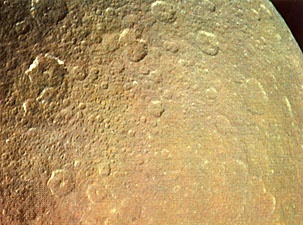Rhea
Greek goddess
in Greek religion, ancient goddess, probably pre-Hellenic in origin, who was worshipped sporadically throughout the Greek world. She was associated with fruitfulness and had affinities with Gaea (Earth) and the Great Mother of the Gods (also called Cybele). A daughter of Uranus (Heaven) and Gaea, she married her brother Cronus, who, warned that one of his children would be fated to overthrow him, swallowed his children Hestia, Demeter, Hera, Hades, and Poseidon soon after they were born. Rhea concealed the birth of Zeus in a cave on Mount Dicte in Crete and gave Cronus a stone wrapped in swaddling clothes. This he swallowed in the belief that it was Zeus. Subsequently, Cronus was vanquished by Zeus and was forced to disgorge the swallowed children.
astronomy
 major regular moon of Saturn and the planet's second largest, after Titan. It was discovered in 1672 by the Italian-born French astronomer Gian Domenico Cassini (Cassini, Gian Domenico) and named for a Titan of Greek mythology.
major regular moon of Saturn and the planet's second largest, after Titan. It was discovered in 1672 by the Italian-born French astronomer Gian Domenico Cassini (Cassini, Gian Domenico) and named for a Titan of Greek mythology.Rhea has a diameter of 1,528 km (949 miles) and revolves around Saturn in a prograde, nearly circular orbit at a mean distance of 527,040 km (327,490 miles) and with an orbital period of about 4.52 Earth days. Rhea's density, which is 1.3 times that of water, indicates that the moon is composed mostly of water ice. In addition, infrared spectral observations show a surface composed mainly of water frost. Like most of Saturn's other major moons, Rhea rotates synchronously with its orbital period, keeping the same hemisphere toward Saturn and the same hemisphere forward in its orbit.
Rhea's surface is highly reflective overall, although large regional variations are apparent. Rhea resembles Saturn's moon Iapetus in size and density, but the distribution of its surface brightness is opposite to that of Iapetus and less extreme. In the latter regard it more resembles its neighbouring moon Dione—its leading hemisphere is bright and heavily cratered, whereas its trailing hemisphere is darker with bright wispy streaks, a paucity of craters, and evidence of resurfacing.
At Saturn's distance from the Sun, frozen water and other volatile substances are so cold that they behave mechanically like rock and can retain impact craters. Consequently, Rhea's bright cratered side strongly resembles the extensively cratered highlands of Mercury or of Earth's Moon. Rhea is in fact the most heavily cratered of Saturn's moons, and the reflective properties of its surface indicate that it is highly porous, like the Moon's impact-pulverized debris layer, or regolith. Bright streaks have been observed on the darker, trailing side of Rhea. It remains to be determined whether the streaks are caused by tectonic activity (faulting) or by the escape of volatiles such as water or methane through fissures and their precipitation on the surface. The leading side of Rhea as it orbits Saturn has a remarkable bright crater with extensive bright rays extending over much of the hemisphere, rather like the spectacular rayed lunar crater Tycho.
- juggler
- Juglar, Clément
- jugular vein
- Jugurtha
- Juhani Aho
- Juho Kusti Paasikivi
- Juigalpa
- Juilliard, Augustus D.
- Juilliard School
- Juin, Alphonse
- Juiz de Fora
- jujitsu
- jujube
- Jujuy
- juku
- Jukun
- Jule Gregory Charney
- Jules-Amédée Barbey d'Aurevilly
- Jules Barthélemy-Saint-Hilaire
- Jules Bastien-Lepage
- Jules Bordet
- Jules Cambon
- Jules, Cardinal Mazarin
- Jules Chevalier
- Jules Chéret